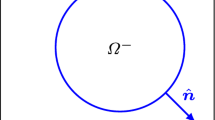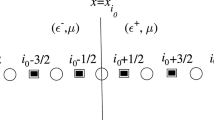Abstract
We propose high-order FDTD schemes based on the Correction Function Method (CFM) (Marques et al. in J Comput Phys 230:7567–7597, 2011) for Maxwell’s interface problems with discontinuous coefficients and complex interfaces. The key idea of the CFM is to model the correction function near an interface to retain the order of a finite difference approximation. To do so, we solve a system of PDEs based on the original problem by minimizing an energy functional. The CFM is applied to the standard Yee scheme and a fourth-order FDTD scheme. The proposed CFM-FDTD schemes are verified in 2-D using the transverse magnetic (\(\hbox {TM}_z\)) mode. Numerical examples include scattering of magnetic and non-magnetic dielectrics, and problems with manufactured solutions using various complex interfaces and discontinuous piecewise varying coefficients. Long-time simulations are also performed to investigate the stability of CFM-FDTD schemes. The proposed CFM-FDTD schemes achieve up to fourth-order convergence in \(L^2\)-norm and provide approximations devoid of spurious oscillations.




















Similar content being viewed by others
References
Abraham, D.S., Giannacopoulos, D.D.: A parallel implementation of the correction function method for Poisson’s equation with immersed surface charges. IEEE Trans. Magn. 53(6) (2017)
Abraham, D.S., Marques, A.N., Nave, J.C.: A correction function method for the wave equation with interface jump conditions. J. Comput. Phys. 353, 281–299 (2018)
Banks, J.W., Buckner, B.B., Henshaw, W.D., Jenkinson, M.J., Kildishev, A.V., Kovačič, G., Prokopeva, L.J., Schwendeman, D.W.: A high-order accurate scheme for Maxwell’s equations with a Generalized Dispersive Material (GDM) model and material interfaces. J. Comput. Phys. 412, 109424 (2020)
Bezanson, J., Edelman, A., Karpinski, S., Shah, V.B.: Julia: a fresh approach to numerical computing. SIAM Rev. 59, 65–98 (2017)
Cai, W., Deng, S.: An upwinding embedded boundary method for Maxwell’s equations in media with material interfaces: 2D case. J. Comput. Phys. 190, 159–183 (2003)
Chen, J., Jarrett, R.: Robust benchmarking in noisy environments. In: HPEC’16 Proceedings of the Twentieth IEEE High Performance Extreme Computing Conference. IEEE (2016)
Cockburn, B., Li, F., Shu, C.W.: Locally divergence-free discontinuous Galerkin methods for the Maxwell equations. J. Comput. Phys. 194(2), 588–610 (2004)
Ditkowski, A., Dridi, K., Hesthaven, J.S.: Convergent cartesian grid methods for Maxwell equations in complex geometries. J. Comput. Phys. 170, 39–80 (2001)
Dridi, K., Hesthaven, J.S., Ditkowski, A.: Staircase-free finite-difference time-domain formulation for general materials in complex geometries. IEEE Trans. Antennas Propag. 49(5), 749–756 (2001)
Fedkiw, R.P., Aslam, T., Merriman, B., Osher, S.: A non-oscillatory Eulerian approach to interfaces in multimaterial flows (the ghost fluid method). J. Comput. Phys. 152, 457–492 (1999)
Ghrist, M., Fornberg, B., Driscoll, T.A.: Staggered time integrators for wave equations. SIAM J. Numer. Anal. 38, 718–741 (2000)
Hesthaven, J.S.: High-order accurate methods in time-domain computational electromagnetics: a review. Adv. Imag. Electron Phys. 127, 59–123 (2003)
Kallemov, B., Bhalla, A.P.S., Griffith, B.E., Donev, A.: An immersed boundary method for rigid bodies. Commun. Appl. Math. Comput. Sci. 11, 79–141 (2016)
Law, Y.M., Marques, A.N., Nave, J.C.: Treatment of complex interfaces for Maxwell’s equations with continuous coefficients using the correction function method. J. Sci. Comput. 82(3), 56 (2020)
Law, Y.M., Nave, J.C.: FDTD schemes for Maxwell’s equations with embedded perfect electric conductors based on the correction function method. J. Sci. Comput. 88(3), 72 (2021)
LeVeque, R.J., Li, Z.: The immersed interface method for Elliptic equations with discontinuous coefficients and singular sources. SIAM J. Num. Anal. 31(4), 1019–1044 (1994)
Marques, A.N.: A correction function method to solve incompressible fluid flows to high accuracy with immersed geometries. Ph.D. thesis, Massachusetts Institute of Technology (2012)
Marques, A.N., Nave, J.C., Rosales, R.R.: A correction function method for Poisson problems with interface jump conditions. J. Comput. Phys. 230, 7567–7597 (2011)
Marques, A.N., Nave, J.C., Rosales, R.R.: High order solution of Poisson problems with piecewise constant coefficients and interface jumps. J. Comput. Phys. 335, 497–515 (2017)
Marques, A.N., Nave, J.C., Rosales, R.R.: Imposing jump conditions on nonconforming interfaces for the correction function method: a least squares approach. J. Comput. Phys. 397, 108869 (2019)
Nguyen, D.D., Zhao, S.: A new high order dispersive FDTD method for Drude material with complex interfaces. J. Comput. Appl. Math. 289, 1–14 (2015)
Nguyen, D.D., Zhao, S.: A second order dispersive FDTD algorithm for transverse electric Maxwell’s equations with complex interfaces. Comput. Math. Appl. 71, 1010–1035 (2016)
Stein, D.B., Guy, R.D., Thomases, B.: Immersed boundary smooth extension: a high-order method for solving PDE on arbitrary smooth domains using Fourier spectral methods. J. Comput. Phys. 304, 252–274 (2016)
Taflove, A.: Computational Electrodynamics : The Finite Difference Time-domain Method. Artech House, Norwood (1995)
Yee, K.S.: Numerical solution of initial boundary value problems involving Maxwell’s equations in isotropic media. IEEE Trans. Antennas Propag. 14(3), 302–307 (1966)
Yu, S., Zhou, Y., Wei, G.W.: Matched interface and boundary (MIB) method for elliptic problems with sharp-edged interfaces. J. Comput. Phys. 224, 729–756 (2007)
Zhang, Y., Nguyen, D.D., Du, K., Xu, J., Zhao, S.: Time-domain numerical solutions of Maxwell interface problems with discontinuous electromagnetic waves. Adv. Appl. Math. Mech. 8, 353–385 (2016)
Zhao, S., Wei, G.W.: High-order FDTD methods via derivative matching for Maxwell’s equations with material interfaces. J. Comput. Phys. 200, 60–103 (2004)
Acknowledgements
The authors are grateful to Alexis Montoison of Polytechnique Montréal for his help on the Julia programming language. The authors also thank Dr. Jessica Lin and Dr. Gantumur Tsogtgerel of McGill University for their support.
Funding
The research of JCN was partially supported by the NSERC Discovery Program.
Author information
Authors and Affiliations
Corresponding author
Ethics declarations
Conflict of interest
The authors have no relevant financial or non-financial interests to disclose.
Availability of data and material
All data generated or analyzed during this study are included in this article.
Code availability
The custom code used for this work is not yet publicly available.
Additional information
Publisher's Note
Springer Nature remains neutral with regard to jurisdictional claims in published maps and institutional affiliations.
Rights and permissions
About this article
Cite this article
Law, YM., Nave, JC. High-Order FDTD Schemes for Maxwell’s Interface Problems with Discontinuous Coefficients and Complex Interfaces Based on the Correction Function Method. J Sci Comput 91, 26 (2022). https://doi.org/10.1007/s10915-022-01797-9
Received:
Revised:
Accepted:
Published:
DOI: https://doi.org/10.1007/s10915-022-01797-9
Keywords
- Interface conditions
- Maxwell’s equations
- Correction function method
- Finite-difference time-domain
- High order




